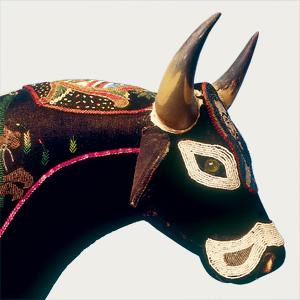Guest post by Brazilian member, Alexandra Oliveira

(source)
This celebration is a mix of African traditions (like “the geroa bull”) with European ones (like the “toradas”, the bullfightings) and some native/indigenous elements from Brazil. The basic account/myth is this one: a rich farmer has a very beautiful ox, an ox that knows how to dance. Father Chico, a worker in the farm, steals the ox to please his wife Catirina (or Catarina), because she is pregnant and she is craving to eat the tongue of that ox. The caboclos (mixed-race farm rangers) along with the native indians (men and women) look for the ox among the cowboys in order to discover who did that. They then arrest Chico. When the rich farmer gets the ox back, it is sick or dead. The “pajes” (indigenous shamans) heal the ox or rresurrect it and find out why Father Chico stole the ox. The farmer forgives him and celebrates the ox’s health with a huge feast.
I see in this party, celebrated between June and July, many things in common with the ancient BOUPHONIA festival, celebrated with the Dipolieia, also between June and July. In the old myth, there is also an ox being killed and many people looking for the guilty one, who is redeemed of his crime. In the Bouphonia, the ox skin is stuffed with hay and sewn so the ox looks like it is alive; in Bumba-Meu-Boi, the ox is actually reborn. Besides that, Father Chico wears a big knife in the dances, and it reminds me of the sharp knife used in the Bouphonia. In the ancient festival, the throat was cut, in the modern one it is the tongue, and both are part of the mouth.
There is also a connection with Dionysos, since the person who plays the role of the pregnant Catirina is a man in drag, and it is the music which magically drums the bull back to life. Besides that, in the style of the Greek theatre, the actors either use masks or cover their faces with charcoal or a coloured mixture of flour and water to imitate a mask.
We know that these ceremonies with the resurrection of an ox probably started with the worship of Apis, in the Nilo river, in Egypt. But, still, it is worthy to compare it with the Greek festival.
The Brazilian legend uses to demonstrate the contrast between the weakness of a man and the strength of an ox. Bumba-meu-boi is a festival which happens in the whole country, the only difference is the name it gets in each district, for example: in Maranhao, Rio Grande do Norte, Alagoas, and Piaui, it is called “bumba-meu-boi”, in Para and Amazonas it is “boi-bumba” or “pavulagem”; in Pernambuco it is “boi-calemba” ou “bumba”; in Ceara it is “boi-de-reis”, “boi-surubim” and “boi-zumbi”; in Bahia it is “boi-janeiro”, “boi-estrela-do-mar”, “dromedário” and “mulinha-de-ouro”; in Parana and in Santa Catarina, it is “boi-de-mourão” or “boi-de-mamão”; in Minas Gerais, Rio de Janeiro, Cabo Frio, and Macaé it is “bumba” or “folguedo-do-boi”; in Espírito Santo it is “boi-de-reis”; in Rio Grande do Sul it is “bumba”, “boizinho”, or “boi-mamão”; in Sao Paulo it is “boi-de-jacá” and “dança-do-boi”. Some of these names in English mean like zombie ox, January ox, starfish ox, dromedary, dance of the ox, papaya ox etc.
So, it’s a nice way to celebrate Bouphonia and also Dionysos, by taking part in or watching these celebrations.
You can find more info (in English) about it in these links:
http://en.m.wikipedia.org/wiki/Bumba_Meu_Boi
http://www.recife.pe.gov.br/especiais/brincantes/ingles/8b.html
And here it goes some videos:
North – http://youtu.be/22qFnPR263g
Northeast – http://youtu.be/BmSxeW0RKYs
South – http://youtu.be/DFXpSaFqeso